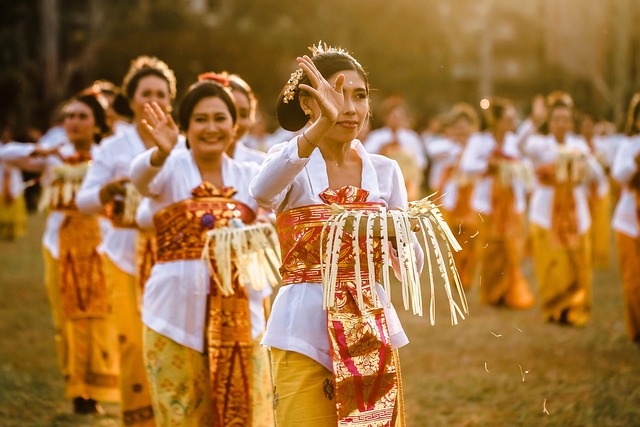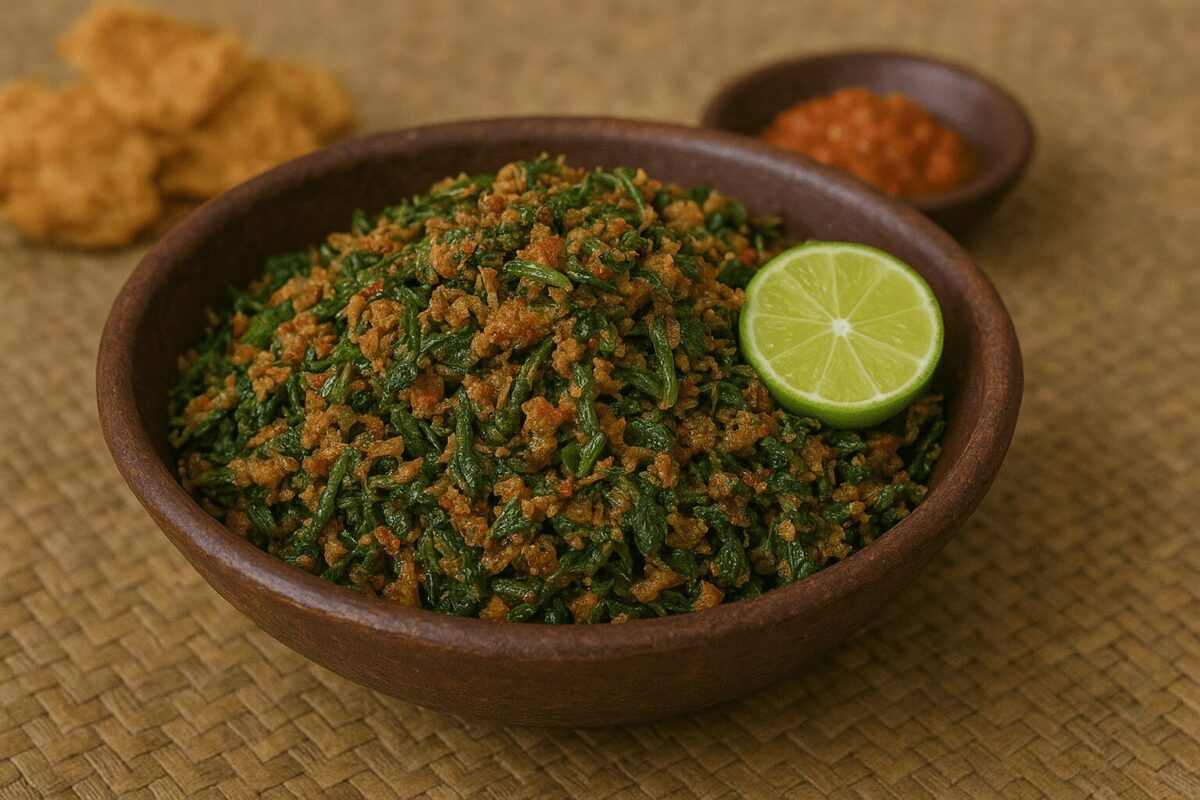The Cultural Soul of Balinese Cuisine
Bali is a land where flavor and faith converge. Every dish tells a story, and every aroma carries centuries of tradition. The Balinese approach to food is deeply spiritual — a reflection of harmony between humans, nature, and the divine. Among the island’s many culinary treasures, Lawar stands as a dish that embodies the heart of Balinese culture. It is not merely sustenance; it is ceremony, symbolism, and shared identity served on a plate.
The Origins of Lawar: Where Tradition Meets Taste
The roots of Lawar extend back to ancient Bali, when cooking was as sacred as prayer. Historically prepared during temple festivals and royal feasts, Lawar symbolized unity — a communal dish crafted by many hands for the gods and the people alike. Passed down orally through generations, its preparation is a ritual as significant as the offering itself, blending devotion with culinary craftsmanship.
A Dish Born from Ceremony and Celebration
Lawar is never a casual affair. It is a dish born from joyous gatherings — weddings, temple anniversaries, and harvest ceremonies. Preparation often involves entire villages, where men and women work side by side, chopping, grinding, and blending. The process is rhythmic, almost meditative. When served, Lawar becomes the centerpiece of celebration, a testament to community and continuity.
Regional Variations Across the Island of the Gods
Just as Bali’s landscapes vary from misty mountains to sun-drenched coasts, so too does Lawar transform from region to region. Northern villages might favor spicy pork renditions, while the southern regions lean toward milder, coconut-rich variations. Coastal communities often substitute seafood, giving the dish an oceanic nuance. Each version captures the soul of its locale — unique, proud, and deeply Balinese.
Understanding the Meaning Behind “Lawar”
The word Lawar is believed to stem from the Balinese term meaning “finely chopped” — a fitting reference to the meticulous preparation of its ingredients. Yet its meaning extends beyond the physical. In Balinese philosophy, Lawar represents balance — between raw and cooked, spicy and mild, body and spirit. It is the culinary manifestation of Rwa Bhineda, the principle of duality in harmony.
The Essential Ingredients That Define Lawar
Every bowl of Lawar is a symphony of texture and taste. It brings together fresh vegetables, minced meat, grated coconut, and an elaborate blend of spices. Each component is prepared separately before being married into a cohesive whole — a metaphor for community and unity within diversity.
Balinese Spices: The Aromatic Foundation
No Lawar can exist without its fragrant foundation — Base Genep. This aromatic paste is the soul of Balinese cuisine, composed of shallots, garlic, turmeric, galangal, ginger, coriander, lemongrass, and candlenut. Ground into a smooth paste and sautéed until golden, it infuses Lawar with warmth and complexity. The aroma alone can transport one to the heart of a Balinese kitchen.
The Role of Coconut and Its Textural Magic
Coconut is both a binder and a flavor enhancer in Lawar. Freshly grated and sometimes roasted, it lends a rich, nutty undertone while adding texture. The subtle sweetness of coconut balances the intensity of spices and the earthiness of meat, achieving a culinary equilibrium that is distinctively Balinese.
Protein Choices: From Pork to Jackfruit and Beyond
Traditionally, Lawar is made with minced pork or duck, though chicken and seafood are also common. Some variations incorporate fresh pig’s blood, giving the dish its signature crimson hue. In vegetarian adaptations, jackfruit or young banana blossom steps in, offering a tender, fibrous bite that mimics meat’s heartiness.
Fresh Herbs and Local Vegetables: The Colorful Ensemble
Vibrant herbs and vegetables breathe freshness into Lawar. Long beans, shallots, kaffir lime leaves, and young papaya are chopped finely to create a mosaic of colors and textures. Together, they add crunch and vitality, transforming the dish into a feast for both the palate and the eyes.
The Making of Lawar: An Art of Balance and Precision
The preparation of Lawar is an act of precision. Each ingredient must be measured, minced, and mixed in perfect proportion. The challenge lies in achieving harmony — not allowing any single element to dominate. It is a culinary choreography, where intuition and ancestral knowledge guide every motion.
Preparing the Base Genep Spice Paste
The Base Genep forms the aromatic backbone of Lawar. Balinese cooks begin by pounding fresh spices into a paste using a stone mortar and pestle. The scent of lemongrass and turmeric fills the air as the paste is slowly fried until its color deepens and the oil releases its perfume. This paste is what gives Lawar its soul — a robust, lingering warmth.
Mixing Tradition: The Ritual of Combining Meat, Blood, and Vegetables
Once the ingredients are prepared, the true ritual begins. Meat and vegetables are mixed by hand — symbolizing unity and sincerity in the act of creation. In traditional Lawar Merah, fresh animal blood is added to the mix, not only for color but as a sacred acknowledgment of life and spirit.
Modern Adaptations for the Contemporary Palate
As Bali evolves, so does its cuisine. Contemporary chefs reimagine Lawar with new ingredients — tofu, tempeh, and even quinoa — while preserving its symbolic heart. Some omit blood for health or ethical reasons, creating versions that are as flavorful yet suited for modern sensibilities.
Lawar Varieties: Exploring the Many Faces of the Dish
Lawar Merah: The Bold and Spicy Red Version
Rich, fiery, and unapologetically bold, Lawar Merah combines pork, coconut, and spices with pig’s blood for a vibrant red hue. It delivers heat and depth — a dish that commands attention and respect.
Lawar Putih: The Gentle and Creamy White Variant
In contrast, Lawar Putih is mild and comforting. Without blood, it relies on coconut milk and aromatic herbs for its creaminess. Its soft flavor embodies serenity, often served at family gatherings or temple offerings.
Lawar Kuwir: Duck Lawar with a Rich Depth of Flavor
Duck lends a luxurious depth to Lawar Kuwir. The meat’s natural richness, combined with spices and coconut, produces a complex taste that lingers long after the last bite.
Lawar Nangka: A Vegetarian Delight with Young Jackfruit
Tender jackfruit replaces meat in Lawar Nangka, absorbing spices effortlessly. This version is both hearty and wholesome, appealing to vegetarians and traditionalists alike.
Lawar Ayam: A Popular Chicken Alternative
A lighter take, Lawar Ayam uses minced chicken blended with shallots, long beans, and coconut. It offers a more delicate yet equally satisfying experience.
Symbolism and Spiritual Significance in Balinese Rituals

Photo by Pixabay / Free to use under license.
Lawar in Temple Offerings and Religious Ceremonies
In Balinese Hinduism, food is a sacred medium of communication with the divine. Lawar plays a pivotal role in offerings, symbolizing gratitude and the balance of life forces. It is served to both gods and men, bridging the earthly and the spiritual realms.
Community Bonds Forged Through Shared Preparation
The making of Lawar is communal. Villagers gather in open courtyards, working together in harmony. This collective act strengthens social ties, fostering unity and mutual respect.
The Social Role of Lawar in Village Life
Beyond ceremonies, Lawar embodies togetherness. It is often shared during village festivals, reinforcing the belief that joy, like flavor, is best when shared.
From Sacred to Everyday: How Lawar Transcended Ritual Spaces
What began as a ceremonial offering gradually became a beloved daily dish. Today, Lawar graces both temple altars and roadside warungs, transcending its ritual origins while retaining its sacred essence.
How to Enjoy Lawar Like a Local
Pairing Lawar with Rice, Sate Lilit, and Sambal Matah
The best way to savor Lawar is alongside warm steamed rice, smoky sate lilit, and the fiery freshness of sambal matah. Together, they create a quintessential Balinese meal — balanced, vibrant, and soulful.
The Best Places in Bali to Experience Authentic Lawar
From family-run stalls in Gianyar to bustling markets in Denpasar, authentic Lawar awaits those who seek it. Each vendor has a signature touch — a secret spice blend, a unique coconut roast — offering a taste of local pride.
Lawar in Modern Bali: Preservation Amid Globalization
Balinese Families Keeping Culinary Heritage Alive
Despite modernization, Balinese households continue to preserve the art of Lawar-making. Recipes are passed down through generations, handwritten on fading paper or remembered by heart.
Lawar’s Role in the Tourism and Culinary Identity of Bali
As Bali’s global fame grows, Lawar stands as a symbol of authenticity. It connects visitors to the island’s true spirit — one of tradition, respect, and shared humanity.
Health Perspectives: Nutritional Insights and Considerations
The Debate Over Raw Blood: Tradition vs. Safety
While pig’s blood lends depth and symbolism, it also raises modern health concerns. Many contemporary cooks choose safer alternatives or omit it entirely, balancing respect for tradition with food safety.
Vegetarian and Vegan Innovations of the Classic Dish
Creative chefs have reinvented Lawar using mushrooms, tofu, and tempeh, preserving its essence while embracing plant-based living. These versions honor tradition while embracing evolution.
Cooking Lawar at Home: A Step into Balinese Culture
Tips for Finding Authentic Ingredients Outside Bali
Seek out Indonesian specialty markets for ingredients like galangal, candlenut, and lemongrass. Fresh coconut can be replaced with unsweetened desiccated coconut if necessary, but authenticity lies in balance — not substitution.
Adapting Lawar to International Kitchens Without Losing Its Essence
Home cooks can simplify the process without diluting its meaning. The key lies in maintaining the harmony of textures and flavors — the very soul of Balinese cooking.
Conclusion: Lawar as a Living Testament to Balinese Identity
Lawar is more than food; it is a vessel of history, faith, and fellowship. Its aroma evokes sacred rituals, and its taste recalls moments of shared joy. As the world changes, Lawar endures — evolving yet eternal, humble yet profound.
A Dish That Tells Stories of Faith, Family, and Flavor
Every bite of Lawar whispers of devotion, togetherness, and gratitude. It stands as a timeless reminder that the true essence of Bali resides not only in its temples or landscapes but in the simple act of sharing a meal prepared with reverence and love.




